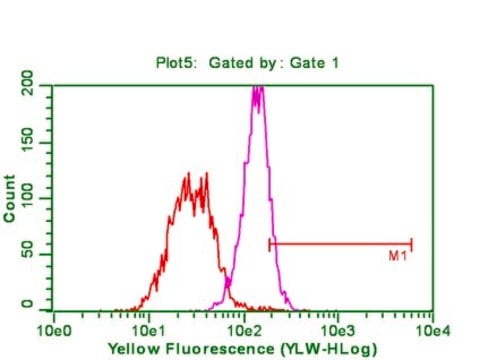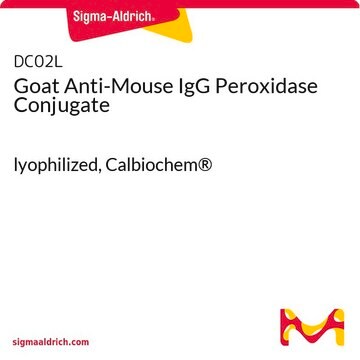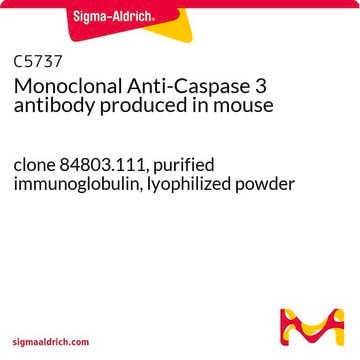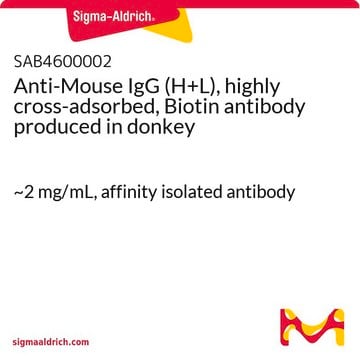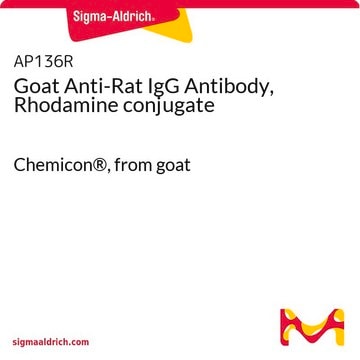AP124R
Goat Anti-Mouse IgG Antibody, Rhodamine conjugate
Chemicon®, from goat
Sign Into View Organizational & Contract Pricing
All Photos(1)
About This Item
UNSPSC Code:
12352203
eCl@ss:
32160702
NACRES:
NA.46
Recommended Products
biological source
goat
Quality Level
conjugate
TRITC conjugate
rhodamine conjugate
antibody form
F(ab′)2 fragment of affinity isolated antibody
antibody product type
secondary antibodies
clone
polyclonal
species reactivity
mouse
manufacturer/tradename
Chemicon®
technique(s)
immunofluorescence: suitable
shipped in
wet ice
target post-translational modification
unmodified
Specificity
Mouse IgG
WAVELENGTH:
Absorption peak = 550 nm, Emission peak = 570 nm.
WAVELENGTH:
Absorption peak = 550 nm, Emission peak = 570 nm.
Application
Goat anti-Mouse IgG Antibody, Rhodamine conjugate detects level of Mouse IgG & has been published & validated for use in IF.
Research Category
Secondary & Control Antibodies
Secondary & Control Antibodies
Research Sub Category
Whole Immunoglobulin Secondary Antibodies
Whole Immunoglobulin Secondary Antibodies
Suggested dilution for most applications: 1:50-1:200 Optimal working dilutions must be determined by end user.
Physical form
Lyophilized. Buffer = 0.01 M Sodium Phosphate, 0.25 M NaCl, pH 7.6 with 15 mg/mL BSA, and 0.05% sodium azide.
RECONSTITUTION:
Reconstitute with 2 mL of sterile distilled water
RHODAMINE/PROTEIN:
Approximately 0.43 (A550/A280).
RECONSTITUTION:
Reconstitute with 2 mL of sterile distilled water
RHODAMINE/PROTEIN:
Approximately 0.43 (A550/A280).
Storage and Stability
Maintain lyophilized product at 2-8°C for up to 12 months. After reconstitution the product is stable for several weeks at 2-8°C as an undiluted liquid. For extended storage after reconstitution, add an equal volume of glycerol to make a final concentration of 50% glycerol followed by storage at -20°C in undiluted aliquots for up to 12 months. Please note the concentration of protein (and buffer salts) will decrease to one-half of the original after the addition of glycerol. Avoid repeated freeze/thaw cycles.
Legal Information
CHEMICON is a registered trademark of Merck KGaA, Darmstadt, Germany
Disclaimer
Unless otherwise stated in our catalog or other company documentation accompanying the product(s), our products are intended for research use only and are not to be used for any other purpose, which includes but is not limited to, unauthorized commercial uses, in vitro diagnostic uses, ex vivo or in vivo therapeutic uses or any type of consumption or application to humans or animals.
Not finding the right product?
Try our Product Selector Tool.
Hazard Statements
Precautionary Statements
Hazard Classifications
Aquatic Chronic 3
Storage Class Code
11 - Combustible Solids
WGK
WGK 3
Certificates of Analysis (COA)
Search for Certificates of Analysis (COA) by entering the products Lot/Batch Number. Lot and Batch Numbers can be found on a product’s label following the words ‘Lot’ or ‘Batch’.
Already Own This Product?
Find documentation for the products that you have recently purchased in the Document Library.
A Sami Saribas et al.
Virology, 540, 104-118 (2019-11-26)
JC virus (JCV) Agnoprotein (Agno) plays critical roles in successful completion of the viral replication cycle. Understanding its regulatory roles requires a complete map of JCV-host protein interactions. Here, we report the first Agno interactome with host cellular targets utilizing
Hui Tang et al.
Neurological research, 30(7), 751-760 (2008-05-24)
Angiotensin II can promote cell stress, and the expression of its AT1 receptor is characteristic of neuronal populations that die off in multiple systems atrophy and Parkinson's disease. To explore the possible significance of these facts, we undertook to: (1)
Marko Ostojic et al.
International journal of molecular sciences, 22(12) (2021-07-03)
Synovitis of the knee synovium is proven to be a precursor of knee osteoarthritis (OA), leading to a radiologically advanced stage of the disease. This study was conducted to elucidate the expression pattern of different inflammatory factors-NF-kB, iNOS, and MMP-9
Jingyi Sheng et al.
Theranostics, 11(6), 2845-2859 (2021-01-19)
Rationale: Transforming Growth Factor-beta (TGF-β) /Smad3 signaling has been shown to play important roles in fibrotic and inflammatory diseases, but its role in beta cell function and type 2 diabetes is unknown. Methods: The role of Smad3 in beta cell
Yu-Show Fu et al.
Stem cells (Dayton, Ohio), 24(1), 115-124 (2005-08-16)
Human mesenchymal stem cells isolated from Wharton's jelly of the umbilical cord were induced to transform into dopaminergic neurons in vitro through stepwise culturing in neuron-conditioned medium, sonic hedgehog, and FGF8. The success rate was 12.7%, as characterized by positive
Our team of scientists has experience in all areas of research including Life Science, Material Science, Chemical Synthesis, Chromatography, Analytical and many others.
Contact Technical Service